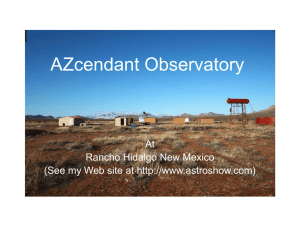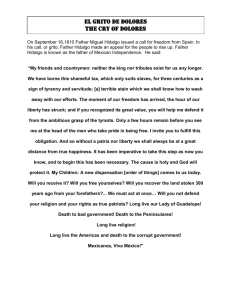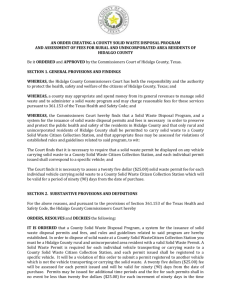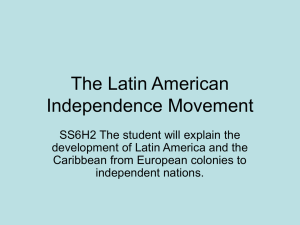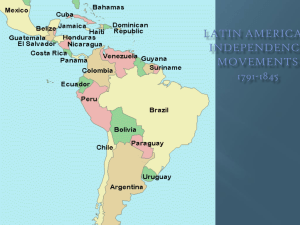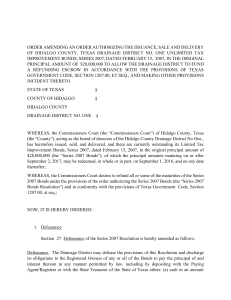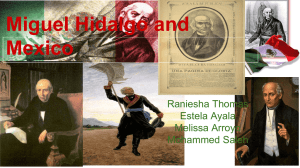San Martín`s contribution to the cause of independence was his
advertisement
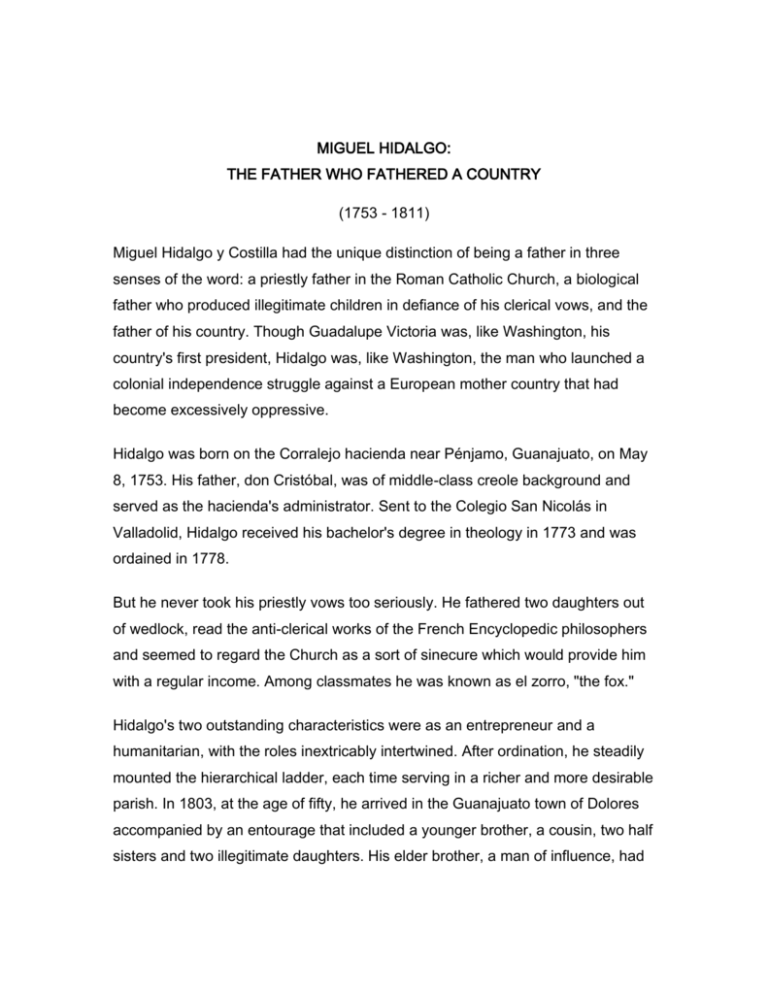
MIGUEL HIDALGO: THE FATHER WHO FATHERED A COUNTRY (1753 - 1811) Miguel Hidalgo y Costilla had the unique distinction of being a father in three senses of the word: a priestly father in the Roman Catholic Church, a biological father who produced illegitimate children in defiance of his clerical vows, and the father of his country. Though Guadalupe Victoria was, like Washington, his country's first president, Hidalgo was, like Washington, the man who launched a colonial independence struggle against a European mother country that had become excessively oppressive. Hidalgo was born on the Corralejo hacienda near Pénjamo, Guanajuato, on May 8, 1753. His father, don Cristóbal, was of middle-class creole background and served as the hacienda's administrator. Sent to the Colegio San Nicolás in Valladolid, Hidalgo received his bachelor's degree in theology in 1773 and was ordained in 1778. But he never took his priestly vows too seriously. He fathered two daughters out of wedlock, read the anti-clerical works of the French Encyclopedic philosophers and seemed to regard the Church as a sort of sinecure which would provide him with a regular income. Among classmates he was known as el zorro, "the fox." Hidalgo's two outstanding characteristics were as an entrepreneur and a humanitarian, with the roles inextricably intertwined. After ordination, he steadily mounted the hierarchical ladder, each time serving in a richer and more desirable parish. In 1803, at the age of fifty, he arrived in the Guanajuato town of Dolores accompanied by an entourage that included a younger brother, a cousin, two half sisters and two illegitimate daughters. His elder brother, a man of influence, had helped him attain this coveted parish, which brought in between eight and nine thousand pesos revenue annually. Once ensconced in Dolores, Hidalgo turned over most of the clerical duties to one of his vicars, Father Francisco Iglesias, and devoted himself almost exclusively to business, intellectual pursuits and humanitarian activity. In a strenuous effort to improve the economic well-being of his parishioners, Hidalgo turned his house into a night school for local artisans. He started a pottery factory, ran a leather curing process, grew mulberry trees for the nourishment of silkworms, cultivated vineyards and olive groves, and established workshops for carpentry, harness making, blacksmithing and weaving wool. Hidalgo's political and intellectual growth was nurtured by membership in the literary societies that were so prevalent in colonial Mexico in the early 19th century. These literary circles, which soon became political circles, were the true incubators of the independence movement in Mexico. Hidalgo's impulse toward freedom for his people was also fed by a strong egalitarian instinct. At both Dolores and San Felipe, his previous parish, Hidalgo opened his house not only to Frenchified creole intellectuals from whom he derived many of his ideas but also to downtrodden Indians and mestizos. It was Hidalgo's empathy with the masses that would be both his great asset and fatal flaw once the independence movement got started. An intellectual comrade -- later to become a comrade in arms -- was a young captain named Ignacio Allende. Allende headed one of the political-literary circles in Querétaro and he and Hidalgo soon became active co-conspirators against Spanish rule. This spirit intensified in 1808, when Napoleon installed his brother Joseph as king of Spain. Though the rebellious creoles in Mexico shared with Napoleon the ideals of the French Enlightenment, they believed that by now Napoleon had become a power-hungry despot and they had no wish to pledge allegiance to his brother. So they originally rallied to the cause of the deposed Bourbon king Ferdinand VII, who later turned out to be an ultra-reactionary. Hidalgo and Allende had originally planned the rising for December 8, 1810. But there were leaks among the conspirators and plans for the rebellion were sniffed out by the magistrate of Querétaro. Fortunately for the conspirators, his wife, Josefa Ortiz, was a strong supporter of the rebellion. Though the magistrate locked her in her room, she signaled her next door neighbor, Ignacio Pérez, to come over. Through the keyhole she told Pérez, a fellow conspirator, that her husband planned to arrest Allende. But Allende had already left to confer with Hidalgo and decide what to do to meet the emergency. The result was Hidalgo's famed grito ("shout") from his pulpit at 11 p.m. of September 15. Though the grito is hailed today as a declaration of independence from Spain, is reality it was a declaration of defiance against Joseph Bonaparte and the Spaniards resident in Mexico as well as a declaration of allegiance to the very undeserving Ferdinand VII. Hidalgo's Nine Laws to Avoid Disorder and Bloodshed, Undated Proclamation. 1. The seizure of Europeans is limited to laymen, and under no circumstances to Ecclesiastics except in the case of high treason. 2. The European be he prisoner or exempted who speaks freely against the object of our expedition, and who vents his anger with insulting expression, will be put to the sword; and the American runs the same risk. 3. The European who spontaneously surrenders to us will be treated with respect, assuring him the security of his life and wealth. 4. The European who resists with arms, shall be put to the sword. 5. When we are menaced by siege and combat, before engaging in it, and at the same time that we begin hostilities, we shall put the many Europeans who are in our hands to the sword. [This invalidates Article 3.] 6. The American, who defends the European with arms, shall be put to the sword. 7. The American who maliciously hides some European giving him aid to revolt, shall be put to the sword. 8. The American who simply through compassion conceals a European without telling our government, will suffer the pain of exile and the confiscation of his property. 9. The informer of any of the mentioned crimes, shall be rewarded with 500 pesos. sdct Reprinted in Hamill, The Hidalgo Revolt, 1960 San Martin & Other Liberations In addition to liberating Venezuela, Simon Bolivar also worked to free other South American countries. These included Columbia, Peru, and Ecuador. Together, present-day Venezuela, Columbia, Panama, and Ecuador formed Grand Columbia. Bolivar created a congress for this new republic, and was also named as its president. While Simon Bolivar was freeing many of the northern South American countries, an Argentinean named Jose de San Martin was working to free the south. San Martin liberated Argentina, Chile, and aided Bolivar in the liberation of Peru. Both Bolivar and San Martin had made efforts to drive the Spanish out of Peru, but they could not accomplish that task alone. This problem brought the two together for a meeting in Guayaquil, Ecuador. What happened during the meeting remains unknown. Afterwards, San Martin turned the control of his army over to Bolivar. Jose de San Martin then returned to his home in Argentina. With the help of San Martin's army, Simon Bolivar was finally able to liberate Peru in 1824. The northern section of Peru was the last area to be liberated, and it was then named Bolivia, after Bolivar. Peninsulares, Latin American citizens who were born in Europe, held all the important government and church positions. Creoles were those who were born in Latin America, but whose ancestors came from Europe. This social class included many of the wealthy landowners. Together, the peninsulares and the creoles made the aristocracy of society. Under these two classes ranked the common people. The common people included mestizos, mulattoes, African Americans, and Native Americans. They had few political rights and little wealth. Most African Americans were enslaved, and Native Americans, though legally free, were treated no better than slaves. San Martín’s contribution to the cause of independence was his military skill. The boldness of his plan to attack the viceroyalty of Lima by crossing the Andes to Chile and going on by sea, as well as the patience and determination with which he executed it, was undoubtedly the decisive factor in the defeat of Spanish power in southern South America. Whether at Guayaquil he consciously made a great renunciation of personal ambition so that Bolívar, and with him the cause of independence, might triumph, or whether he went into voluntary exile because Bolívar made it clear that he was not prepared to help Peru so long as San Martín remained in control, remains an unresolved historical problem.
